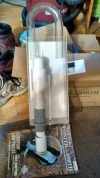clancaster23
Reefing newb
I'm finally putting together my first sump and in the process of putting the plumbing together. Only thing that worries me now is having either the main tank or the sump overflow on me during an outage. We tend to get them rather often for whatever reason around where I live, coincidentally we had one last night for six hours. I need to be 100% sure that if the power does go out that I don't get a pool in my room. I was told that I should drill a small hole in return pipes that would sit just below the water line in the main tank and that would break the siphon if the power ever did go out. I posted a pic of the overflow box I'm using. Maybe that can give someone an idea of whether it's a good one to use and if I have anything to worry about and what more I can do to prevent flooding during an outage.
My phone refuses to send the pic to my email so I'll post it when I can. Basically it has a big U-tube that transfers the water from the tank to the back into the overflow part and that has two different chambers, it's split half and half and one side fills up and pours into the drain side.
My phone refuses to send the pic to my email so I'll post it when I can. Basically it has a big U-tube that transfers the water from the tank to the back into the overflow part and that has two different chambers, it's split half and half and one side fills up and pours into the drain side.

